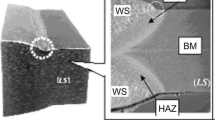A procedure is proposed for the determination of the endurance limit of butt-welded joints of low-carbon steels under different high-frequency mechanical peening conditions from the maximum depth value of plastically deformed layer using experimental microhardness measurement data.







Similar content being viewed by others
References
V. I. Trufiakov, E. S. Statnikov, P. P. Mikheev, and A. Z. Kuzmenko, “The efficiency of ultrasonic impact treatment for improving the fatigue strength of welded joints,” IIW Doc. XIII-1745-98 (1998).
P. P. Mikheev, A. Ya. Nedoseka, I. V. Parkhomenko, et al., “Effectiveness of using eltrasonic shock treatment to increase the fatigue resistance of welded joints,” Avtomat. Svarka, No. 3, 4–7 (1984).
V. A. Degtyarev and B. S. Shul’ginov, “Estimation of the efficiency of methods aimed at increasing the fatigue resistance of welded joints under impact loading at low temperatures,” Strength Mater., 32, No. 6, 571–576 (2000).
V. A. Degtyarev, “Assessment of the high-frequency mechanical forging mode effect on fatigue strength of welded joints,” Strength Mater., 43, No. 2, 154–160 (2011).
L. M. Lobanov, V. I. Kyr’yan, and V. V. Knysh, “Increasing the life of welded metallic structures by high-frequency mechanical peening,” Fiz.-Khim. Mekh. Mater., No. 1, 56–61 (2006).
G. I. Prokopenko, Ya. I. Kleiman, O. V. Kozlov, et al., Device for the Ultrasonic Shock Treatment of Metals [in Ukrainian], Patent No. 47536 of Ukraine, Valid since July 15, 2002.
V. V. Knysh, S. A. Solovei, and I. L. Bogaichuk, “Optimization of the process for strengthening welded joints of 09G25 steel by high-frequence mechanical peening,” Avtomat. Svarka, No. 5, 26–31 (2011).
V. A. Degtyarev, “Equipment of type DSO for fatigue testing in repeated impact and harmonic loading with various stress ratios,” Strength Mater., 14, No. 10, 1413–1416 (1982).
V. A. Degtyarev, “Effect of weld strengthening techniques on the fatigue resistance enhancement,” Strength Mater., 45, No. 5, 574–586 (2013).
GOST 9450–76. Microhardness Measurement by the Pressing-In of Diamond Indenters [in Russian], Introduced since January 1, 1977.
S. V. Serensen, V. P. Kogaev, and R. M. Shneiderovich, Load-Carrying Ability and Strength Design of Machine Components [in Russian], Mashinostroenie, Moscow (1975).
S. S. Manson and U. Muralidharan, “Fatigue life prediction in bending from axial fatigue information,” Fatigue Frañt. Eng. Mater. Struct., 9, No. 5, 357–372 (1987).
V. I. Kir’yan and V. V. Knysh, “High-frequency mechanical peening of welded joints of metallic structures”, Avtomat. Svarka, No. 11, 36–41 (2008).
Author information
Authors and Affiliations
Additional information
Translated from Problemy Prochnosti, No. 6, pp. 71 – 80, November – December, 2014.
Rights and permissions
About this article
Cite this article
Degtyarev, V.A., Gopkalo, E.E. Effect of High-Frequency Mechanical Peening Conditions on Increase in the Fatigue Resistance of Butt-Welded Joints. Strength Mater 46, 777–784 (2014). https://doi.org/10.1007/s11223-014-9611-1
Received:
Published:
Issue Date:
DOI: https://doi.org/10.1007/s11223-014-9611-1




